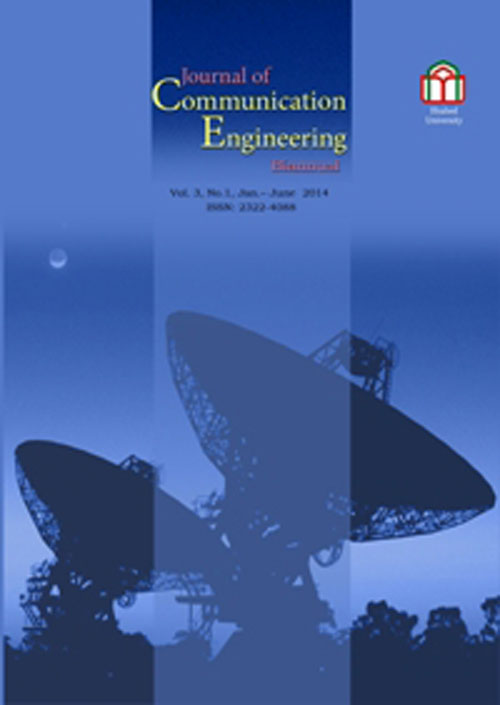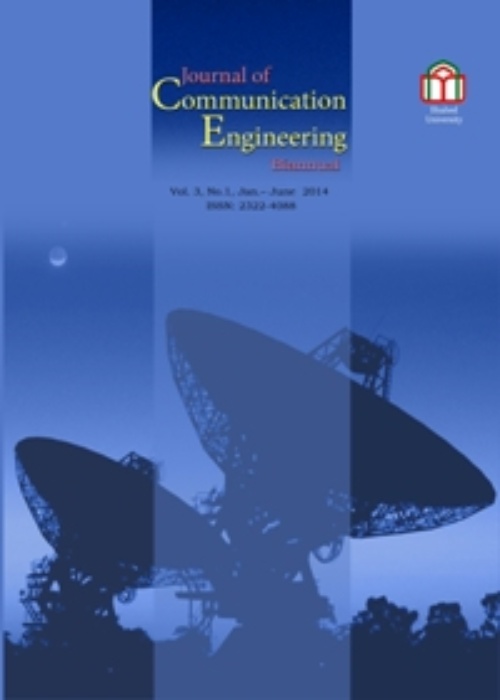فهرست مطالب

Journal of Communication Engineering
Volume:7 Issue: 1, Spring 2018
- تاریخ انتشار: 1397/03/10
- تعداد عناوین: 10
-
-
Pages 1-10Non-destructive detection and evaluation of invisible cracks in metal structures is an important matter in several critical environments including ground transportation, air transportation and power plants. In this paper, a high-Q near-field Microwave probe is designed and fabricated using defected ground structures for surface and subsurface crack detection in metal structures. For this purpose, several near-field probes with different DGSs are designed and probe with the highest quality factor is selected for subsurface detection. Experimental results show that the proposed probe is able accurately detect invisible crack of a size 1mm with at least 20dB magnitude and more than 300 degrees phase contrast. It has also been demonstrated that the proposed device can efficiently used for detection and imaging of small failure and crack in dielectric and metallic structures. Also, it is noted that if the probe dimensions scale down, spatial resolution for crack detection of size in micro and nanometer is achieved at millimeter waves.Keywords: Microwave imaging, near-field probe, defected ground structures, crack detection
-
Pages 11-22A new shaped circularly polarized dielectric resonator antenna (CP DRA) is studied with branch-line coupler and log-periodic balun for the GPS application. Since the coupler and balun are located under the DRA, it does not increase the footprint of the antenna, as a result the system is very compact. Two configurations are considered in this paper. In the first configuration, an external 50Ω load is used for the matching port of the branch-line coupler. For the second one, a three-resonator log-periodic balun is used instead of branch-line coupler, thus, no lumped elements are required in this configuration. Moreover, two modes HEM11δ of the cylindrical DRA are utilized to design the wide band circular polarization. The reflection coefficient, axial ratio, antenna gain, and radiation pattern are studied for each configuration. These first and the second configurations offer an impedance bandwidth (S11Keywords: Circular polarization, dielectric resonator antenna, coupler, balun
-
Pages 23-33This paper presents a data focusing method (DFM) to image extended targets using the multiple signal classification (MUSIC) algorithm. The restriction on the number of transmitter-receiver antennas in a microwave imaging system deteriorates profiling an extended target that comprises many point scatterers. Under such situation, the subspace-based linear inverse scattering methods, like the MUSIC algorithm, fail to image the extended targets. In proposed method, the DFM divides imaging region into several sections and maps the scattered data to each section by applying a linear transformation. Being weakened clutters from other sections, the resultant focused data contains, mostly, the responses of scatterers inside the desired section. In this way, the number of scatterers is reduced comparing to the number of transmitter-receiver antennas and the requirement for the MUSIC is satisfied. Using experimental data, we show that the DFM in conjunction with the MUSIC is successful in microwave imaging of extended targets.Keywords: Microwave imaging, MUSIC algorithm, Focusing method, Extended target
-
Pages 34-48In this paper we investigate the sub-channel assignment and power control to maximize the total sum rate in the uplink of two-cell network. It is assumed that there are some sub-channels in each cell which should be allocated among some users. Also, each user is subjected to a power constraint.
The underlying problem is a non-convex mixed integer non-linear optimization problem which does not have a trivial solution. To solve the problem, having fixed the consumed power of each user, and assuming low co-channel interference region, the sub-channel allocation problem is reformulated into a more mathematically tractable problem which is shown it can be tackled through the so-called Hungarian algorithm.
Then, the consumed power of each user is reformulated as a quadratic fractional problem which can be numerically derived. Numerical results demonstrate the superiority of the proposed method in low SNR region as compared to existing works addressed in the literature.Keywords: Sub-Channel assignment, Power control, Mixed Integer Non Linear Problem, Hungarian algorithm -
Pages 49-61In this paper, a new structure is provided for the dispersion compensating photonic crystal fibers in order to broaden the chromatic dispersion and increase the dispersion compensating capability in a wide wavelength range. In the structure, putting a combination of circular holes and a star structure in the inner core clad causes the dispersion coefficient profile to be broadened, and additionally causes the fiber to have a negative dispersion coefficient in the whole S to U telecommunication bands. In this fiber, the minimal dispersion coefficient will be -653ps/(nm.km). Furthermore, with the diameter of the circular holes of the inner clad in this structure increased, a relatively flat dispersion profile will be obtained in the whole E to U telecommunication bands with a dispersion variation equal to 46ps/(nm.km). In the S to C telecommunication bands, the dispersion variation is 17ps/(nm.km). The simulations are all done using the finite difference time domain numerical (FDTD) method.Keywords: Chromatic dispersion, Dispersion compensation, Negative dispersion, Photonic crystal fiber
-
Pages 62-71recently a new structure called groove gap waveguide (GGW) is ýintroduced to implement low loss microwave component devices ýespecially for millimeter wave applications. This paper presents a ýnew type of H-plane horn antenna making use of this new technology ýin which backward radiation is significantly suppressed by ýintroducing a high impedance surface at the antenna aperture. The ýhigh impedance surface that we used as the back lobe suppressor is a ýcorrugated surface. The designed antenna is simulated by HFSS and ýits radiation performance is compared with an ordinary GGW H-ýplane horn in which no back lobe suppression mechanism is used. ýResults show a significant improvement in back lobe suppression and ýgain enhancement by the proposed structure.ýKeywords: Groove Gap Waveguide (GGW), Horn Antenna, Back lobe Suppression
-
Pages 72-83A compact printed fractal antipodal bow-tie antenna is designed and implemented to simultaneously cover the operations in the C, X, and Ku-bands. It is demonstrated that by addition of small fractal elements at the sides of hexagonal arms of the bow-tie, a wide operating frequency range of 3.3 to 19.1 GHz can be covered while antenna size is only 30×34×1.2 mm3. In order to match the antenna to the 50Ω SMA connector, a multi-section microstrip line of different widths is designed. The simulation results obtained from HFSS simulator package are verified by experimental measurements. Measured data are in good agreement with the simulated results. The frequency- and time-domain characteristics of the antenna including impedance matching, far-field patterns, radiation efficiency, gain, and fidelity factor are presented and discussed. The proposed antenna features 141% impedance bandwidth (defined by -10-dB reflection coefficient), small size, and desirable radiation patterns that make it excellent candidate for integration in broadband array systems.Keywords: Fractal elements, hexagonal radiators, printed fractal antipodal bow-tie antenna (PFABTA), super-wideband
-
Pages 84-97This paper concerns to blind identification of a convolutional code with desired rate in a noiseless transmission scenario. To the best of our knowledge, blind estimation of convolutional code based on only the received bitstream doesnt lead to a unique solution. Hence, without loss of generality, we will assume that the transmitter employs a non-catastrophic encoder. Moreover, we consider a complete synchronous scenario in which one can extract separate codewords from received sequence. This assumption is valid in many practical communication systems because, the frame preambles allow us to identify the beginning of each codewords.
In this paper, we examine the blind identification problem for rate1/n and rate k/n convolutional codes, respectively. For rate 1/n, we propose an iterative method that uses three steps in each iteration to test the validity of a possible value of n. We show that this method can identify the parameters of a rate 1/n convolutional code from only two different noiseless received codewords. Afterwards, we generalize this method for a rate k/n convolutional code in which each iteration is composed of seven successive steps. We show that this method requires at least k different codewords to identify all parameters of a rate k/n code.Keywords: Blind estimation, convolutional code, cognitive radio, non-catastrophic encoder, minimal-basic encoder -
Pages 98-101This paper presents the shaping optimization of an S-band cylindrical offset reflector antenna with cosecant-squared radiation pattern in elevation plane. The cross section of the antenna is mathematically modeled by a polynomial function and optimized by the genetic algorithm to obtain the desired pattern for both TE and TM polarizations. The physical optics method together with the uniform theory of diffraction is used to efficiently calculate the radiation pattern during the optimization. Numerical results show that the cosecant-squared radiation pattern can be achieved with good accuracy for angular span of 50◦. The computed radiation pattern agrees well with method of moments as well as CST software and deviates less than about 0.7 dB, on average, from the ideal cosecant-squared pattern.Keywords: Cosecant-squared pattern, genetic algorithm, physical optics, reflector antenna, uniform theory of diffraction
-
Pages 102-117In this paper, the secrecy problem in the state dependent causal cognitive interference channel is studied. The channel state is non-causally known at the cognitive encoder. The message of the cognitive encoder must be kept secret from the primary receiver. We use a coding scheme which is a combination of compress-and-forward strategy with Marton coding, Gelfand-Pinsker coding and Wyners wiretap coding at the cognitive encoder. We use rate splitting for messages at both transmitters. Furthermore, the cognitive user compresses its channel observation using Wyner-Ziv coding and splits the index of its compressed signal. By using this scheme we derive an achievable secrecy rate region for this channel and extend the results to the Gaussian case and provide some numerical results.Keywords: Causal cognitive interference channel, State dependent channel, secrecy, Achievable secrecy rate region, rate-equivocation


